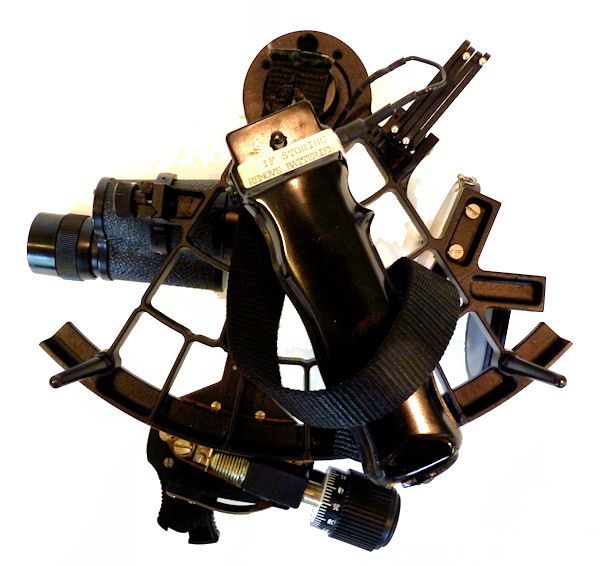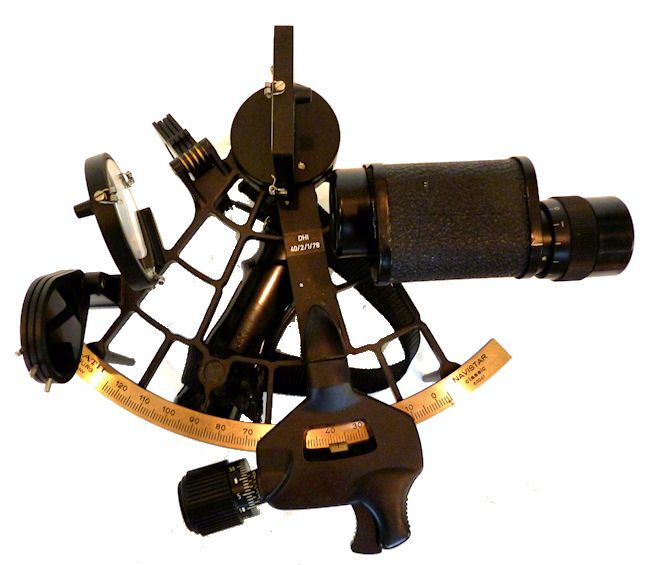
Presented is one of the rarest Plath Navistar sextants that we have offered. It was used in the 1986, Steger International Polar Expedition to the North Pole by the team lead by Will Steger and Paul Schurke its co-leader, navigator. The idea was to test themselves and their equipment dogsleding to the Pole with only what they were able to carry with them. No unsupported attempt had ever been made. Helped originally by 49 Huskies and Canadian Eskimo dogs, of the eight that started, Bob Mantell and Bob McKerrow, after enduring untold hardships, dropped out due to injuries. This left five men and one woman, and 20 remaining sled dogs, to make Arctic history.
On May 1, 1986 after fifty six days, and mushing 1000 punishing miles, twice the straight line distance, from the Ellesmere Island, the Canadian departure point, the remaining team reached their goal. Not only was the achievement heroic, but it was met with major recognition from newspapers, magazines and television. Suggested reading, Vol 170, No 3, September, 1986 of “National Geographic” magazine whose feature article, “North to the Pole” details the exploit with numerous pictures. And, in the January, 1987 issue of “Outside Magazine” the expedition was further honored by receiving the prestigious “Outsiders of the Year” award. Print media included the New York Times, Boston Globe, Philadelphia Inquirer, Los Angles Times, USA Today, Sports Illustrated and others with TV coverage provided by Good Morning America and CBS Morning News. Many of them ran multi-segments covering this outstanding achievement.
 |
|
L to R: Ann Bancroft, Brent Brody, Will Steger, Paul Schurke, Geoffrey Carroll
and Richard Weber six of the eight starters. Credit Dupont Corporation
|
SEXTANT 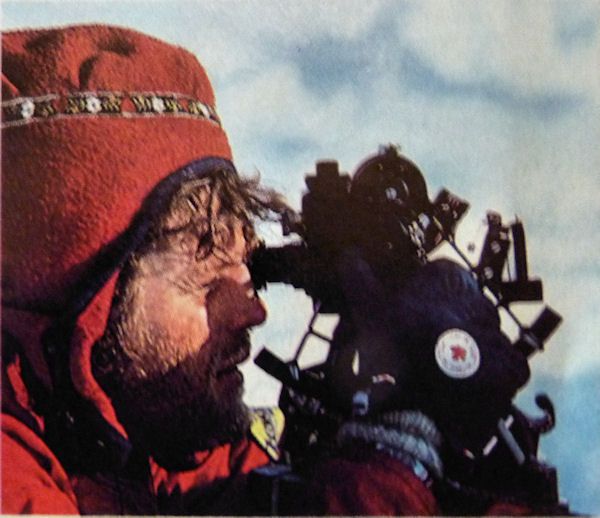 MODIFICATIONS: A Nylon safety strap has been fitted to the handle to protect against dropping it in the harsh environment in which it was used. Offshore navigators typically use a safety lanyard for the same purpose. The cover to the battery compartment was modified by drilling a central hole and adding a screw. This cut the wire spring that exerts pressure on the batteries. The spring now needs to be fitted to the last battery by hand. A second hole and screw were added to the left side of the cap to act as a retainer. Schurke writes that this was to keep it from unscrewing due the the sleds’ vibrating. Picture at right shows navigator, Paul Schurke shooting the morning sun.
MODIFICATIONS: A Nylon safety strap has been fitted to the handle to protect against dropping it in the harsh environment in which it was used. Offshore navigators typically use a safety lanyard for the same purpose. The cover to the battery compartment was modified by drilling a central hole and adding a screw. This cut the wire spring that exerts pressure on the batteries. The spring now needs to be fitted to the last battery by hand. A second hole and screw were added to the left side of the cap to act as a retainer. Schurke writes that this was to keep it from unscrewing due the the sleds’ vibrating. Picture at right shows navigator, Paul Schurke shooting the morning sun.
PROVENANCE and CONDITION SUMMARY: The remarkable thing is that this sextant was returned to the States when team member Bob Mantell was evacuated with frozen feet near the end of the two month expedition. It was sent to Plath for reconditioning and adjustment. The result is it was put back in “Like New” condition and on April 14, 1993 was returned to Mantell in Palm Beach Gardens, FL and later went into his storage in Ely, MN where it remained for the past nineteen years. Plath did not touch the case which had been modified inside to suit the needs of Schurke, the navigator. Covered in numerous places by silver duct tape, its appearance did not measure up to that of the sextant so it was reconditioned in our shop. The separation at the joints of the case, due to the rigors of the Arctic remain, and the top is slightly out of register with the bottom. The green absorbent interior liner of the top section was cut by Shurke in a number of places, and remains just like it was modified. The exterior of the case which shows some warping on its vertical edges remains strong. The duct tape was removed and the finish reconditioned. The scuffing and scratches from the Expedition remain. The inside of the case now looks as pictured. The arrow on the right is pointing at the label signed by Frank Janicek stating that the sextant was last collimated by Plath on December 20, 1992.
 |
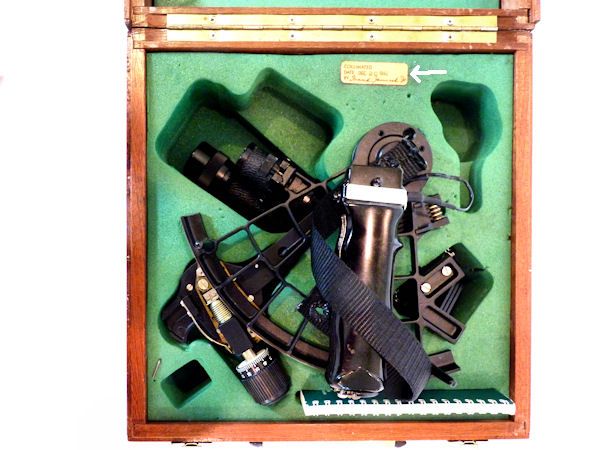 |
| Interior of case’s top showing modifications | Bottom case with sextant housed at 20° index |
STAR RANKING:
Taking the non-standard condition of the case and the minor change in the sextant’s handle and the reconditioned case, we classify it as a whole in excellent condition with 5 Stars, and suitable for a collection or use at sea.
This is the 20th Navistar we’ve offered. In our opinion, they are the finest of contemporary sextants.
They will be equally desirable at sea or in a collection of only the best, and should only appreciate in value.
NO CERTIFICATE OF ACCURACY: There is a Plath manual, but there are no Plath papers with this instrument. However there is a recognition orange label signed by Frank Janicek, Jr. dated Dec 20, 1992 that it was last collimated as of then. In addition, we have tested it thoroughly and can guarantee it is in perfect condition with near ZERO index error and a slight side error which is a good thing. Based on our proprietary register of C. Plath instruments, we can also date it by its serial number, 63241 as being made in late 1983 or early 1984.
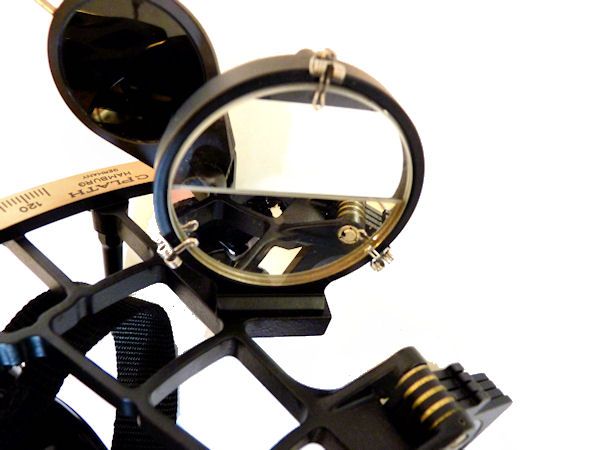 |
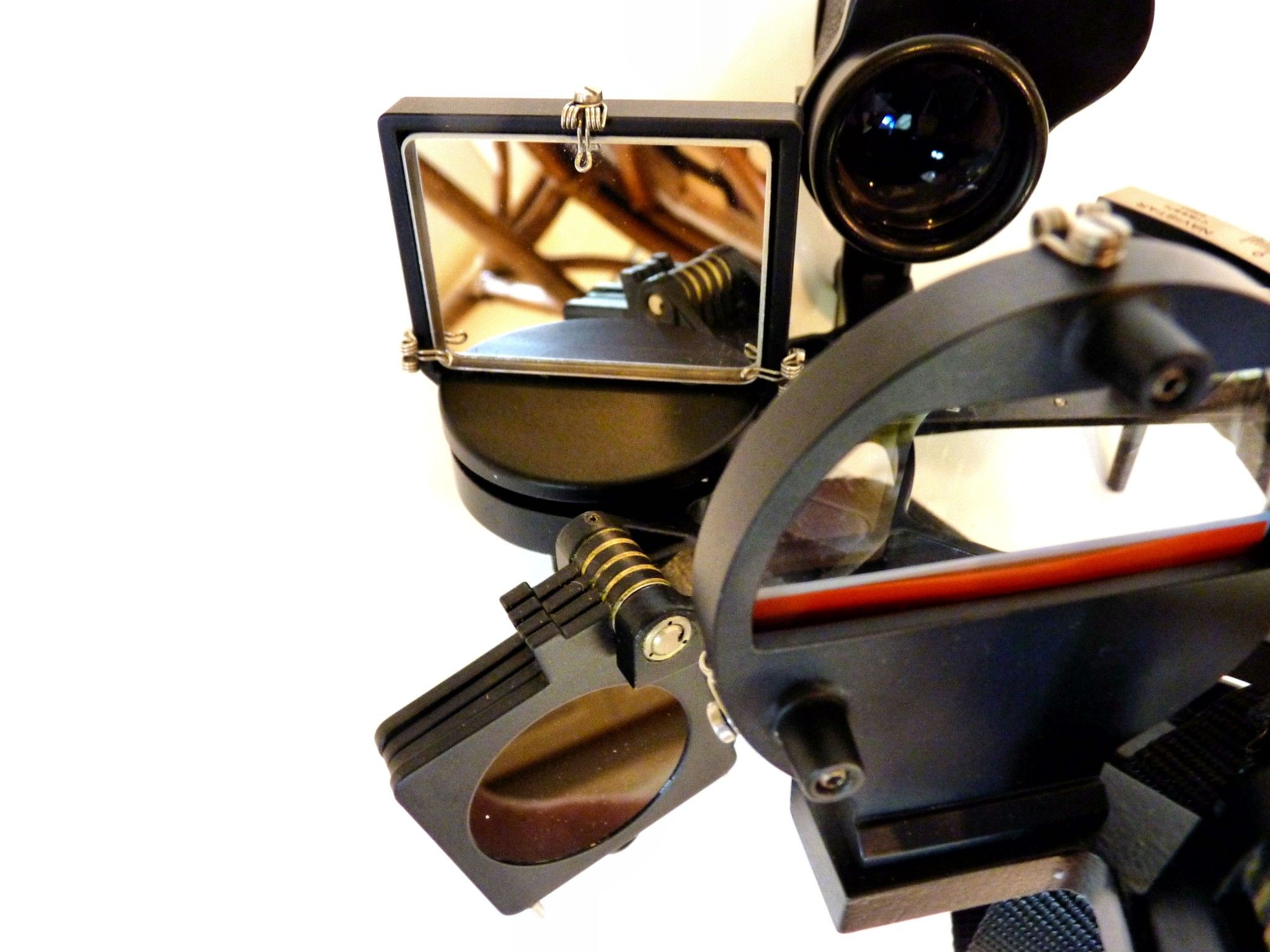 |
| Perfect split image horizon mirror | As new index mirror |
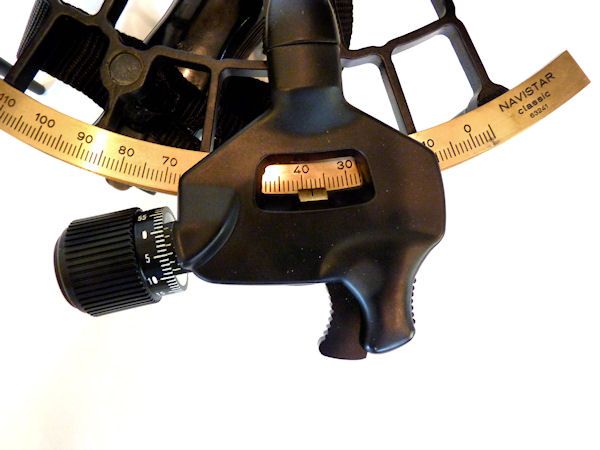 |
 |
| Special micrometer & vernier | Navistar imprint & serial number |
REFERENCES:
Vol 170, No 3, September, 1986, “National Geographic” magazine, “North to the Pole”. January, 1987 issue.
“Outside Magazine”, “Outsiders of the Year” award. The Steger Expedition, Journey to the Top of the World. Dupont Corporation, July 1, 1986 April 26, 2012 letter from Paul Shurke about this sextant.The sextant is housed in a Mahogany wood case with energy absorbing green liner. The sextant sits in the case with its handle up, ready for use, a handy feature. On its index arm is the Deutche Hydrographic Institute seal of approval.DHI LABEL: The Deutche Hydrographic Institute stamp of approval elevates it to the highest level because it indicates this instrument was tested by DHI, and found to meet the more stringent standards for commercial use. Hence, this sextant sold for more originally then the regular Navistar Classic.
The Navistar Classic was the top of the Plath line and was made in limited quantities, and was manufactured with a guaranteed non-adjustable instrument error of 10 arc seconds or less. It sold for a premium over all its other sextants. For example, almost 30 years ago, they sold for over $1000.00, and as recently as 2001, the price had risen to $4000.00.
SCROLL ALL THE WAY DOWN TO EXPEDITION PHOTO GALLERY.
Credit National Geographic and Outside magazines
WHAT IS A NAVISTAR CLASSIC:Don’t confuse this model with the similarly named “Navistar Professional“ which. in our opinion is the worst sextant made by Plath or the “Navistar Traditional“ which was made shortly before sextant production ended. That instrument has an error up to 20 arc seconds.
You can identify the “Navistar Classic” by these clues:
1. It has a special micrometer drum
2. The Navistar brand imprint on the arc.
3. The vernier has six indents and reads to 10 seconds of arc.
4. Comes with a fine wood case with a green absorbent liner,
5. And originally came with an instruction booklet, and Plath’s
certification with matching numbers
Some like this one have a label from the Deutche Hydrographic Institute dated 2/1/78 certifying them for commercial service. All these features are present with this instrument except the certificate, and the manual included is a photocopy.
For the seven year period from 1978 through 1985 only 1693 Navistar Classics were made. That is only 211 per year to satisfy worldwide demand.
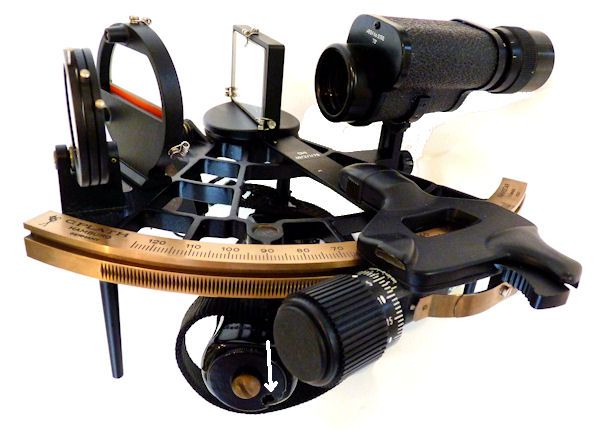
ADDITIONAL COMMENTS: The arrow in the picture above is pointing to where the Schurke added lock screw has been removed from the battery cover. The instrument operates like a well oiled piece of machinery. Both mirrors show as NEW. All the chrome hardware sparkles, and the illumination works. The bronze arc shows “as new”. All the paint is well bonded and looks fresh. There is little index and side error. There is no certificate which is not uncommon, and unnecessary in C.Plath sextants since the Navistar Classics were made to a tested accuracy of 10 arc seconds or less. For practical purposes this makes them error free in use. The no lock case case has some minor scuff and other marks from handling. A brush is also missing. Even though used on the 1986 Arctic Expedition, it remains one of the finest Navistar sextants we’ve ever oferred.
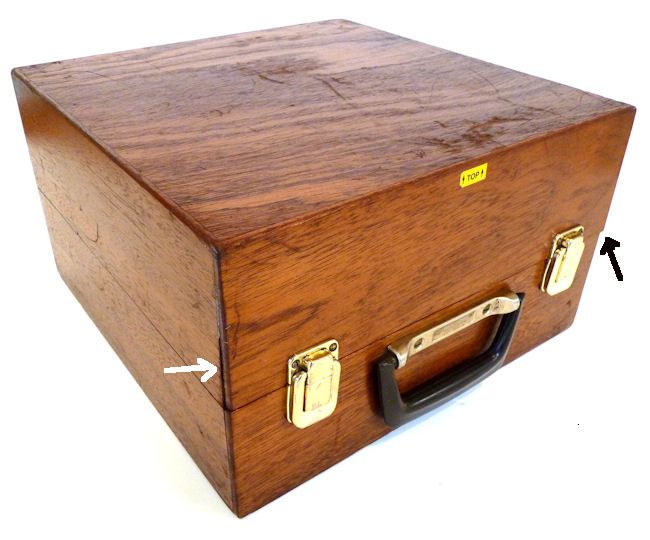 |
| Reconditioned case has minor separation at joints and is slightly out of register |
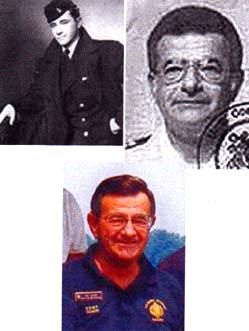 QUALIFICATIONS: We are one of the few company’s still selling navigation instruments that know anything about them. For purposes of judging whether Joel’s opinion counts, he was the editor of the chapter on sextants of the 1977 Edition of “Bowditch”, The American Practical Navigator, NAVPUB 9; a member of the U.S. Naval Academy Navigation Symposium,
QUALIFICATIONS: We are one of the few company’s still selling navigation instruments that know anything about them. For purposes of judging whether Joel’s opinion counts, he was the editor of the chapter on sextants of the 1977 Edition of “Bowditch”, The American Practical Navigator, NAVPUB 9; a member of the U.S. Naval Academy Navigation Symposium,1975 -1978; the author of a book on marine sextants, Cornell Maritime Press,1975, and the founding president of Nautech Maritime Corporation which partnered with Tamaya of Japan in the introduction of the MS 733 Spica, the MS 833, Jupiter, MS 933 Venus sextants and the famous NC-2 navigation computer, in the U.S. market. Joel is a retired Master Mariner, and held a U.S. Navy “D” Qualification as a Senior Skipper – Oceans. For six years he was a Varsity Offshore Sailing Team Coach at the U.S. Naval Academy. Some of his memberships have included the: Association of Naval Aviation, Silver Wings, The Tailhook Association, Naval Academy Sailing Squadron, McCampbell’s Aces Squadron, Naval Historical Foundation, and the Naval Order of the United States.
COMPANY HISTORY: In brief, Carl Plath started manufacturing sextants, in addition to other nautical products, in Hamburg Germany in 1862 though the purchase of the David Filby instrument company though the company’s origin dates back to 1837. As a result WW II, C.Plath was dismantled completely by the occupation forces. Around 1950, various prohibitions were lifted, and C. Plath was allowed to begin production again of sextants and other nautical instruments. Also in 1949,C.Plath was offered a gyrocompass patent and in 1951 the first gyrocompass designed to this patent was presented to the public. C.Plath progressed from the role of instrument maker to that of a modern marine navigation equipment manufacturer. In the following years the product range was expanded by many more modern designs such as autopilots, speed logs, radio direction finders, etc.
In 1962 C.Plath was acquired by Litton Industries, a large American concern.The C.Plath North American Division was set up in 1978 in College Park near Washington. 1996 saw the introduction of the world’s first fiber-optic solid-state gyrocompass by C.Plath. The first ever gyrocompass with no moving parts. Sperry Marine was formed in 1997 with the combination of C.Plath, Decca Marine and Sperry Marine with more organizational changes yet to come. After 163 years, C.Plath changes its name to Sperry Marine in May 2000. In 2001 Sperry Marine becomes part of the Northrop Grumman Corporation. In the 1990’s Plath came out with a series of new sextant designs with overlapping designs and confusing names. They seemed to have lost their way. Shortly thereafter, C. Plath quit producing sextants. The parent company has completely liquidated everything including machinery,
equipment and spare parts.
C. PLATH NAVISTAR CLASSIC SPECIFICATIONMeasuring
Range: -5 to 125 degrees
Telescope: 4 x 40 Coated optics
Frame: Bronze
with black enamel paint and bronze arc.
Micrometer Drum and Vernier Scale: reads to 10 seconds of
arc
Index Mirror: 59 x 44 mm. aluminized on the rear side.
Horizon Mirror:
57mm diameter.
Shades:
4 for index mirror
3 for horizon
mirrorWeight sextant: 4.2 lbs with
4 x 40 scope.
Weight case 6 lbs.
INCLUDED ARE:
Varnished Mahogany sextant case- Missing is the certificate of accuracy and a brush
ACCEPTED FORMS OF PAYMENT are Bank wire transfer, cashier’s check, or personal check in which case the item will be held until cleared. No checks from overseas buyers, no credit cards or PayPal accepted on this item.
This is the 20th Navistar Classic or one of its variations that we have offered since 2005. In our opinion,
they are the finest of the contemporary sextants. They will be equally desirable at sea or in a collection of only the finest.
